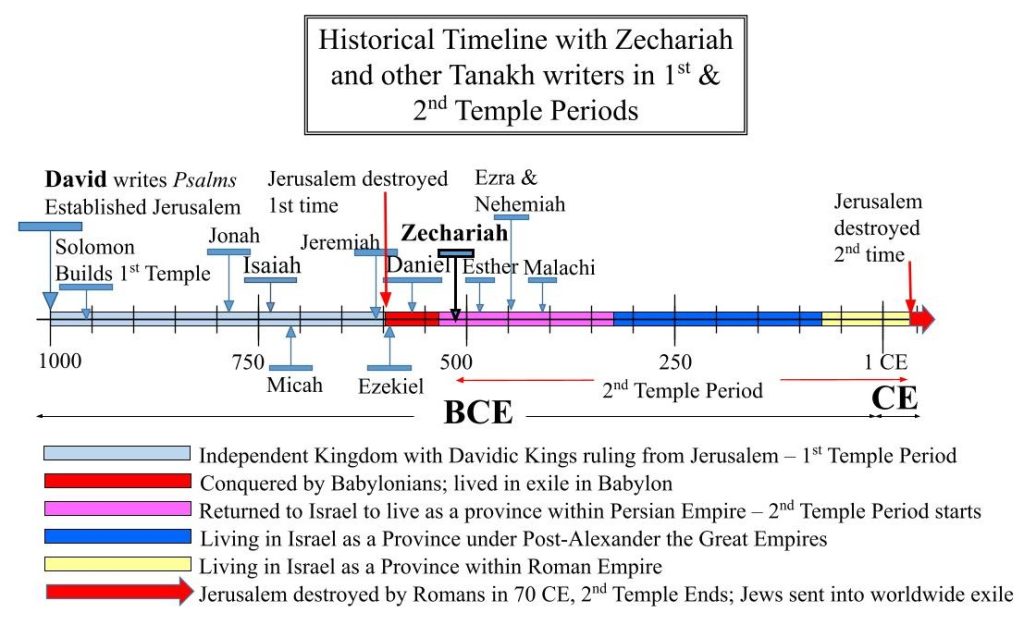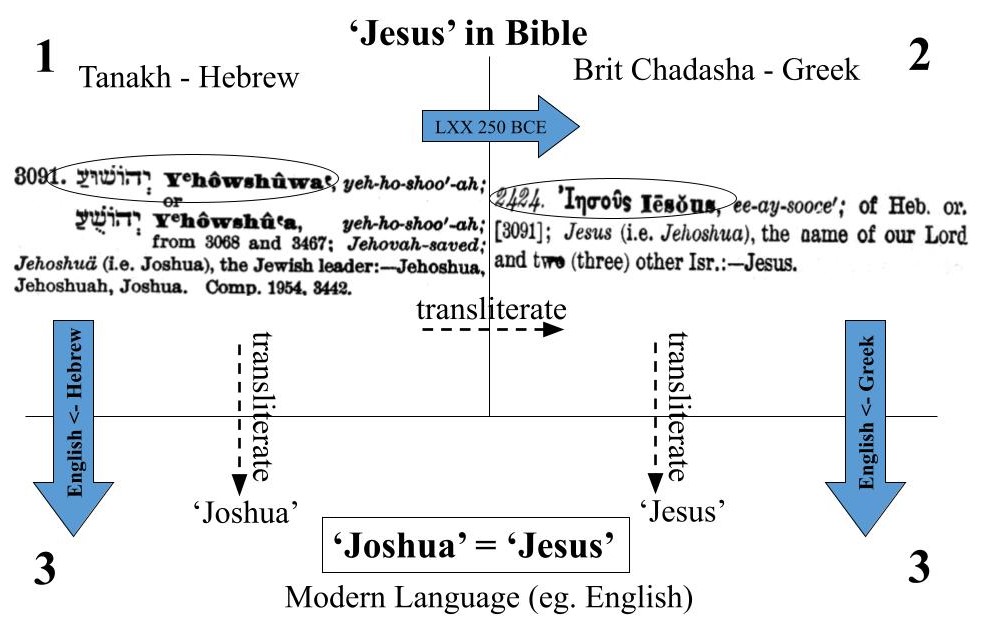We saw how Isaiah began the prophetic theme of The Branch. A ‘he’ from the fallen dynasty of David, possessing wisdom and power was coming. Jeremiah followed up by stating that this Branch would be known as Adonai (the Lord) himself.
Zechariah continues The Branch

Zechariah lived 520 BC, just after the Jewish people returned to Jerusalem from their first exile. At that time, they were rebuilding their destroyed temple. The High Priest then was a man named Joshua, and he was re-starting the work of the priests. Zechariah, the prophet, was partnering with his colleague Joshua, the High Priest, (and Zerubbabel the political leader) in leading the Jewish people. Here is what G-d – through Zechariah- said about this Joshua:
‘”Listen O High Priest Joshua and your associates seated before you, who are men symbolic of things to come: I am going to bring my servant the Branch.” …, says the LORD Almighty, “and I will remove the sin of this land in a single day”.’
(Zechariah 3:8-9)
The Branch! Started by Isaiah 200 years beforehand, continued by Jeremiah 60 years earlier, Zechariah develops ‘The Branch’ further. The Branch is now also called ‘my servant’ (the Servant of Adonai). In some way Zechariah’s colleague, the High Priest Joshua in Jerusalem at 520BCE, was symbolic of this coming Branch. But how? It says that in ‘a single day’ the sins will be removed by the LORD. How would that happen?
The Branch: Uniting Priest & King
To understand we need to know that the roles of Priest and King were strictly separated in the First Temple Period. None of the Davidic Kings could be priests, and the priests could not be kings. The priest’s role was to mediate between G-d and man by offering animal sacrifices to G-d for atonement of sins, and the King’s job was to rule with justice. Both were crucial; both were distinct. This separation of role was cemented in that priests could only be Levites descended from Aaron, while the kings were from David’s line within the tribe of Judah. Yet Zechariah wrote that in the future:
‘The word of the LORD came to me: “…Take the silver and gold and make a crown, and set it on the head of the high priest Joshua. Tell him this is what the LORD Almighty says, ‘Here is the man whose name is the Branch, and he will branch out from his place and build the temple of the LORD… and he will be clothed with majesty and will sit and rule on his throne. And he will be a priest on his throne. And there will be harmony between the two’’
(Zechariah 6:9-13)
Here, against all previous rules, the high priest Joshua in 520 BCE was to put on the kingly crown symbolically as the Branch. (Remember that Joshua was ‘symbolic of things to come’). Joshua the High Priest, in putting on the kingly crown, foresaw a future uniting of King and Priest into one person – a priest on the King’s throne. Furthermore, Zechariah prophesied that ‘Joshua’ was the name of the Branch. What did that mean?
The name ‘Joshua’ is the name ‘Jesus’
To understand we need to review the history of the Tanakh’s translation. The original Hebrew Tanakh was translated into Greek in 250 BCE by Jewish rabbis and is today known as the Septuagint or LXX. Still widely used, we saw how ‘Christ’ was first used in the LXX and we now follow that same analysis through the Masoretic Hebrew and the Greek Septuagint for ‘Joshua’

You can see that Joshua is an English transliteration of the original Hebrew name ‘Yhowshuwa’ (יְהוֹשֻׁ֣עַ). Quadrant #1 shows the Hebrew ‘Joshua’ (יְהוֹשֻׁ֣עַ) as it was first written. It is transliterated to ‘Joshua’ in English (#1=> #3). ‘Yhowshuwa’ (יְהוֹשֻׁ֣עַ) in Hebrew is the same as Joshua in English.

When the LXX was translated Hebrew to Greek in 250 BCE (יְהוֹשֻׁ֣עַ) was transliterated to Iesous (#1 => #2). ‘Yhowshuwa’ (יְהוֹשֻׁ֣עַ) in Hebrew is the same as Iesous (Ἰησοῦ) in Greek.

When the Greek is translated to English, Iesous is transliterated to ‘Jesus’ (#2 => #3). Iesous (Ἰησοῦ) in Greek is the same as Jesus in English.

Jesus was called Yhowshuwa (יְהוֹשֻׁ֣עַ) in Hebrew, but in the Greek Brit Chadasha his name was written as ‘Iesous’ – identical to how the Greek Tanakh LXX wrote that name. When the Brit Chadasha is translated from Greek to English (#2 => #3) ‘Iesous’ is transliterated to the familiar ‘Jesus’. So the name ‘Jesus’ = ‘Joshua’, with ‘Jesus’ going through an intermediate Greek step, and ‘Joshua’ coming directly from the Hebrew. Both Jesus of Nazareth, and Joshua the High Priest of 520BCE had the same name, יְהוֹשֻׁ֣עַ in their native Hebrew. In Greek, both were called ‘Iesous’.
Is Jesus of Nazareth the Branch?
Is this a prediction, made in 520 BCE, that the name of the coming Branch would be, in English terms, ‘Jesus’, pointing directly to Jesus of Nazareth?
Jesus of Nazareth is well-known outside the gospels. The Jewish Talmud, Josephus and all other historical writers about Jesus, both friendly and hostile, always referred to him as ‘Jesus’ (Iesous) or ‘Christ’, so his name was not invented in the Gospels. But Zechariah predicted this name 500 years before he lived.
Jesus of Nazareth is ‘from the stump of Jesse’ since Jesse and David were his ancestors. Jesus possessed wisdom and understanding to a degree that sets him apart from others. His shrewdness, poise and insight portrayed in the Brit Chadasha continue to impress both critics and followers. His power through miracles in the gospels is undeniable. One may choose not to believe them; but one cannot ignore them. Jesus fits the quality of possessing exceptional wisdom and power that Isaiah predicted would one day come from this Branch.
Now think of the life of Jesus of Nazareth in the gospels. He claimed to be a king – The King in fact. This is what ‘Christ‘ means. But what he did while on earth was actually priestly. The priest’s job was to offer acceptable sacrifices to G-d on behalf of the Jewish people. The death of Jesus in the Brit Chadasha was significant in that, it also, was an offering to G-d, on our behalf. The sins of the land were thus literally removed ‘in a single day’ as Zechariah had predicted – the day Jesus died and paid for all sins. In his death he fulfilled the requirements as Priest, even while he is mostly known as ‘The Christ’ or The King. Thus, as Zechariah prophesied, he did bring the two roles together.
But this is the view of Jesus’ death taken in the Brit Chadasha. Does the Tanakh support the same point-of-view? We explore this by following up on the related theme that Zechariah above equated with the Branch – that of the Servant.